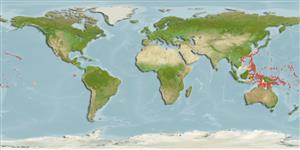Actinopterygii (ray-finned fishes) >
Perciformes (Perch-likes) >
Gobiidae (Gobies) > Gobiinae
Etymology: Ctenogobiops: Greek, kteis, ktenos = comb + Latin, gobius = gudgeon + Greek, ops = appearance (Ref. 45335).
Environment / Climate / Range
Ecology
Marine; reef-associated; depth range 4 - 40 m (Ref. 1602), usually 4 - 40 m (Ref. 27115). Tropical; 22°C - 25°C (Ref. 27115), preferred ?; 30°N - 15°S
Pacific Ocean.
Size / Weight / Age
Maturity: Lm ? range ? - ? cm
Max length : 6.0 cm TL male/unsexed; (Ref. 9710)
Dorsal
spines
(total): 7;
Dorsal
soft rays
(total): 10-11;
Anal
spines: 1;
Anal
soft rays: 10 - 11. Characterized by having semi-translucent whitish body; orange spots interspersed with small white or bluish spots on body; dorsal fin brownish "pennant"; basal part of pectoral fin with white marking forming long, diffuse narrow white streak; greatly prolonged first and second dorsal spines; longitudinal scale series 47-51; opening of gill extending forward to vertical at posterior edge of eye; greatest depth of body 4.3-5.2 in SL; rounded caudal fin, except straight in central part, about equal to head length (Ref. 90102).
Occurs in patches of fine sand on seaward reefs and uses alpheid shrimp burrows for refuge. Found in clear coastal and inner reefs on rubble flats and slopes in 6-20 meters depth range (Ref. 48637).
Life cycle and mating behavior
Maturity | Reproduction | Spawning | Eggs | Fecundity | Larvae
Randall, J.E., G.R. Allen and R.C. Steene, 1990. Fishes of the Great Barrier Reef and Coral Sea. University of Hawaii Press, Honolulu, Hawaii. 506 p. (Ref. 2334)
IUCN Red List Status (Ref. 115185)
CITES (Ref. 94142)
Not Evaluated
Threat to humans
Harmless
Human uses
Aquarium: commercial
More information
Common namesSynonymsMetabolismPredatorsEcotoxicologyReproductionMaturitySpawningFecundityEggsEgg development
ReferencesAquacultureAquaculture profileStrainsGeneticsAllele frequenciesHeritabilityDiseasesProcessingMass conversion
Tools
Special reports
Download XML
Internet sources
